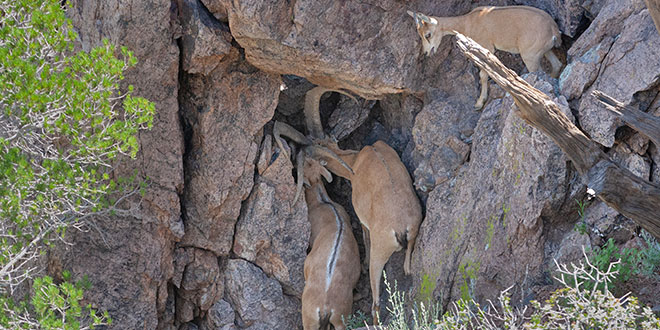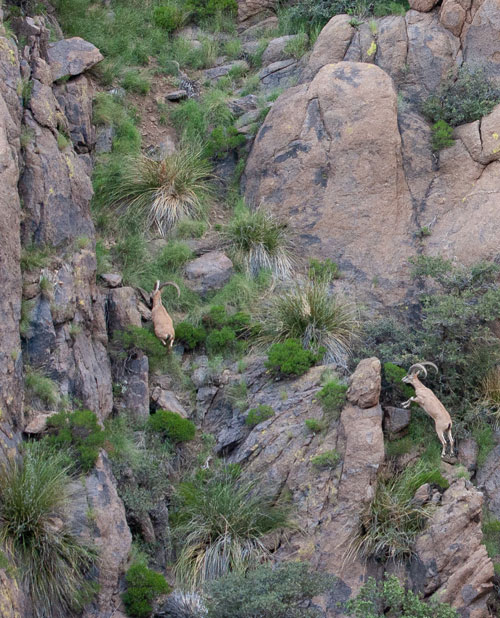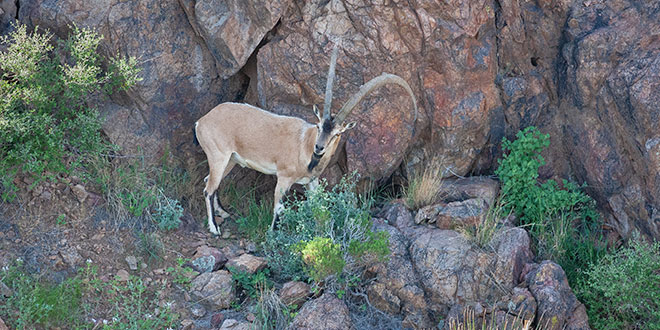For the outdoorsman, New Mexico offers several excursions to partake in, especially when it comes to big game hunting. Every year, tens of thousands of hunters across the country apply for the annual New Mexico big game draw, and every year in April, those hunters are hoping, dreaming and praying to see the color green and the word “successful” on their applications.
There are several species of big game to pursue in New Mexico including trophy quality elk, antelope, deer, black bear and bighorn sheep. However, New Mexico is also the only state in the country that offers free-ranging exotic big game without special advantages for the hunter including high fences or feeders.
The three species of exotic game within New Mexico are African gemsbok, commonly known as oryx, Barbary sheep (also called aoudad sheep) and
Persian ibex.
Of the three species, one is gaining popularity due to the absolute challenge it offers hunters in pursuing it.
The Persian ibex (Capra aegagrus) inhabits the nearly impossible-to-scale Florida Mountains of southwest New Mexico. The ibex’s adaptations, combined with the challenge offered by the terrain, make ibex a trophy that is truly earned. Known to some in the archery community as the “Toughest Hunt in North America,” ibex hunting with a bow carries a success rate between one to seven percent on average. This is one of the most abandoned hunts in North America, meaning more hunters give up and quit due to the extreme challenge the hunt offers.
Ibex are an exotic big game animal that came to inhabit the Florida Mountains back in 1970 when the Department of Game and Fish imported 15 ibex from Iran. Shortly after, an additional 27 were released. By 1974, the Department held its first ibex hunt for the public. Ever since then, hunts have been conducted in the fall. As the hunting industry has grown in popularity, and filming has become more common, the demand for ibex tags has increased.
With New Mexico being the only place where a hunter can find free ranging ibex within the Western Hemisphere, ibex hunting is quickly and rapidly growing in popularity. This is absolutely one of the toughest hunts in North America, whether using a firearm or a bow. The reason more people quit this hunt is, shortly after beginning, they realize that they truly have bit off way more than they could ever hope to handle. Those select few hunters who are successful harvesting an ibex with a bow join a very elite club of hunters.
********

Located just south of the small town of Deming, with steep peaks jutting from the Chihuahuan desert floor and extending towards the heavens, are the legendary Florida Mountains. The base of this 12-mile long mountain range, nicknamed “The Rock” by the locals, sits at approximately 4,300 feet. The peaks of the mountains range between 5,000 to 7,500 feet. The Floridas are split into two separate ranges. The main mountains are known as the Florida Mountains, but to the east is a smaller range known as the “Little Floridas.” This smaller range is not as tall as its counterpart, and there is a road that hunters can access to get on top of the Little Floridas.
Only firsthand witnesses can attest to The Rock and the challenges it puts forth to anyone who wishes to climb it. The mountains are littered with steep canyons, vertical cliffs and loose rocks that make climbing and walking a challenge all its own. The average time it takes to hike to the top is between two to four hours, if the person is an experienced hiker. For people who do not know the terrain, the mountains are very deceiving. Hunters will often start on a path, believing it will take them to the top, and will find the trail will dead-end by an unseen obstacle. They are forced to back-track and look for another way to the top.
Roads in and around the Floridas are rough at best, unmaintained and littered with washouts that deepen each year from wind and rain. There are no roads that take hunters to the top of the mountains. Hunters are strongly encouraged to have a good four-wheel drive vehicle or an off-highway vehicle (OHV). Mesquite surrounds the mountains and will puncture a tire in a heartbeat. Along with a four-wheel drive vehicle, hunters also need a spare tire.
Combine all of these factors with the fact that the mountains are covered with cacti, mesquite and other plants that sting and poke—and are an absolute haven for rattlesnakes—hunters have a very daunting task when pursuing ibex in the Florida Mountains. During my climbs of the Floridas, I have found it difficult at best. I had to keep pushing myself to continue as each step slid on the loose rocks. Once I reached the top, I felt a sense of enlightment and estonishment as I gazed at the magnificent view that was before me.
********

Strategies for hunting ibex are few and far between. Glassing is the first crucial step. Spotting ibex can be a challenge at first, until a hunter learns what and where to look. Even when the billies have a white coat, they can still blend in perfectly with the mountain. The minimum glass a hunter needs is a good spotting scope, preferably 20×60, and a good pair of binoculars, minimum of 12x. After spotting a group, hunters need to establish a game plan before heading up the mountain. That game plan includes several factors such as: number of ibex in the group, general direction of travel, time of day, terrain, how to get into position and so on.
Having your weapon sighted in and ready to shoot seems elementary, but there are some hunters who have missed shots because something was wrong with their weapon or they did not prepare properly. Hunters are encouraged to not only sight their weapon in, but practice in the right conditions: windy, cross winds and steep angles.
Then, before going up the mountain, it is also strongly encouraged to shoot your weapon and make sure it is sighted in. One of the worst feelings is putting on a stalk for several hours on a billy of a lifetime and coming up short because of an inaccurate shot.
Most successful ibex hunters are successful because they work with a team. A team will make the hunt easier, more enjoyable and a team can provide encouragement. A minimum team consists of the hunter, one person to climb the mountain with and one person who stays below and glasses for the hunter. Ibex can move very quickly on the mountain. You’ll glass them in one spot, and when you get into position, the ibex have already moved over the mountain. A spotter can give the hunter updates on the movements of the ibex. Also, hunters cannot see what is above or below them sometimes due to the steep angles. This is when a spotter comes in most handy to relay to the hunter the position of the ibex. Hunters using a spotter need to trust their spotter and listen to them. The spotter can see what you can’t.
The teammate that is on the mountain with the hunter is great for helping with glassing, but they’re even better after the ibex is down, from taking great field photos, field dressing to finally packing the animal out. Ibex may not weigh much compared to other species, but with the rough terrain, it is wise to split the load for the climb down. Most of the teams I have encountered have four to six members.

A guide once told me, “You can’t deer hunt ibex, you’ve got to ibex hunt ibex.” What he means by this is ibex are their own animal, they do not share behavioral charactertics with any other animal in North America, so hunters shouldn’t try hunting ibex like other animals. So when it comes to attempting to sit over water or a natural mineral deposit, it can be hit or miss. Ibex do need water, but they can get it from several sources on the mountain. If a hunter is going to attempt sitting on water or a mineral deposit, the hunter needs to do their homework with trail cameras and glassing to see if ibex frequently visit a certain water source or mineral deposit. Once the hunter has established that the ibex visit a certain place, they can build a natural blind to wait for a shot opportunity.
To view more ibex photos from Department big game program manager Nicole Tatman, visit https://magazine.wildlife.state.nm.us/ a-rare-glimpse-persian-ibex-in-the-floridas/.”
Some hunters attempt to save their legs the strain of constantly climbing The Rock day in and day out by camping on the mountain. This is a great strategy, but it should be combined with a spotter below to relay ibex positions up to the hunters. Before attempting this, hunters need to consider the supplies they will need while camped out. One of the main things is water. Hunters are still in the desert and water is an important factor that they need. Hunters will have to pack in enough water to sustain them throughout their stay atop the mountain, and that much water can be very heavy.
Ibex hunting is not only challenging, but it can also be very dangerous. Aside from the possibility of falling to your death on a steep cliff, there are many more dangers lurking on The Rock. As mentioned before, rattlesnakes are common during the October hunt. A hunter can expect to see, if not almost step on, one to three rattlesnakes per day! Another danger is the sun and heat. Hunter who do not stay properly hydrated won’t last long. Staying hydrated not only means replenishing water, but keeping your electrolytes balanced. During the 2019 October archery hunt, two experienced hunters became dehydrated, and had to be rescued by Border Patrol Agents. The hunters drank plenty of water, but due to the heat, humidity, and amount of water lost through sweat, they became dehydrated. Weather in the desert can change in an instant, and hunters need to be prepared for rain, cold winds and even snow. If a hunter does not have the proper equipment, they will succumb to hyperthermia. Hunters need to prepare for the unexpected, because in the Florida Mountains, help is almost never close by. This hunt is not for lone beginners. Experience can be the difference between life and death on this mountain, and it should not be taken for granted – another great reason to hunt with others. Some great sources of information on ibex hunting are the internet, videos or calling the local conservation officer.
Ibex are a truly magnificent animal to behold, and an even more magnificent animal to hunt. They’re not an easy animal to pursue, but at the end of the hunt, everyone finds a whole new perspective of tough hunting. Some return for more adventures, others are one and done. No matter the outcome, The Rock is a memorable experience that will test a hunter’s fortitude and persistence in pursuing the impossible goat. For the successful applicants this season, and future applicants to come, I hope this sheds some light on the mystery surrounding the Florida Mountains and ibex hunting.
One of the most difficult hunts in North America
There are two archery hunts offered that occur in October and January. Both hunts are 15 days in length. The two archery hunts are known as some of the most difficult hunts with a bow in North America. The average success rate is between one to seven percent each year. Shots can range anywhere from 20 to 120 yards. Hunters are strongly encouraged to practice shooting in high winds, cross winds and steep angles to prepare them for the Florida Mountains. Ibex hunting with a bow is an uphill battle.
Florida Mountains
The name of the mountains, which is pronounced as Floor-ee-da, is Spanish for “flowery.” Spaniards in the 1700s named the mountains after they saw the large expanse of flowers that grow on them during the spring.
Ibex Facts
• Ibex stand approximately 30 inches to the top of the shoulders.
• Adult males are called “billies” and can weigh between 100–150 pounds.
• Adult females, or “nannies,” are smaller and usually weigh about 90 pounds.
• Both sexes possess horns.
• Any ibex is a trophy that is truly earned, but most hunters seeking a “trophy” ibex are looking for a billy with horn lengths of 36” or larger.
• During the summer and early fall, both sexes are light brown in color. This coloration allows them to blend in perfectly with the mountains. Once the winter months arrive, the mating season begins and mature billies undergo a drastic change of color. Their coats change from light brown to a light cream color, sometimes even to snow white.
 New Mexico Wildlife magazine Conserving New Mexico's Wildlife for Future Generations
New Mexico Wildlife magazine Conserving New Mexico's Wildlife for Future Generations
